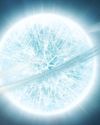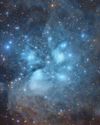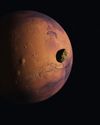
Mars is the fourth planet from the Sun. Befitting the Red Planet’s bloody colour, the Romans named it after their god of war. The bright rust colour Mars is known for is due to iron-rich minerals in its regolith – the loose dust and rock covering its surface. The soil of Earth is a kind of regolith, too, albeit one loaded with organic content. The iron minerals on Mars oxidise, or rust, causing its soil to look red.
The planet’s thin atmosphere means liquid water likely cannot exist on the Martian surface for any appreciable length of time. Features called recurring slope lineae may have spurts of briny water flowing onto the surface, but this evidence is disputed; some scientists argue the hydrogen spotted from orbit in this region may instead indicate briny salts. This means that although this desert planet is just half the diameter of Earth, it has the same amount of dry land.
The Red Planet is home to both the highest mountain and the deepest, longest valley in the Solar System. Olympus Mons is roughly 25 kilometres (16 miles) high, about three times as tall as Mount Everest, while the Valles Marineris system of valleys – named after the Mariner 9 probe that discovered it in 1971 – reaches as deep as ten kilometres (six miles) and runs east to west for roughly 4,000 kilometres (2,500 miles), about one-fifth the distance around Mars and close to the width of Australia.
Esta historia es de la edición Issue 124 de All About Space.
Comience su prueba gratuita de Magzter GOLD de 7 días para acceder a miles de historias premium seleccionadas y a más de 9,000 revistas y periódicos.
Ya eres suscriptor ? Conectar
Esta historia es de la edición Issue 124 de All About Space.
Comience su prueba gratuita de Magzter GOLD de 7 días para acceder a miles de historias premium seleccionadas y a más de 9,000 revistas y periódicos.
Ya eres suscriptor? Conectar

MYSTERIES OF THE UNI WHERE ARE ALL THE SPIRAL GALAXIES?
There are far fewer spiral galaxies than elliptical ones in the Supergalactic Plane, and scientists are keen to discover why

ZOMBIE STARS
+10 OTHER TERRIFYING SPACE OBJECTS

HOW TO BEAT LIGHT POLLUTION
Thought it was impossible to observe the wonders of the night sky from towns and cities? Think again. Follow our tips and tricks on successfully observing through sky glow

15 STUNNING STAR CLUSTERS
These beautiful stellar groupings are spattered across the cosmos

Eileen Collins "It was a difficult mission...we were the first to see Mir"
Having served as both the first female pilot and first female commander of NASA's Space Shuttle, Collins boosted the involvement of women in space exploration to a whole new level

MARS LEAKS FASTER WHEN IT'S CLOSER TO THE SUN
The Red Planet has lost enough water to space to form a global ocean hundreds of kilometres deep

FUTURE TECH KANKOH-MARU
This ambitious reusable spacecraft will be capable of taking 50 people to and from orbit

THE FINAL FRONTIER
Beyond the reach of the Sun is a fascinating region of the cosmos that were only just beginning to explore

A long-lost moon could explain Mars' weird shape and extreme terrain
A long-lost moon could explain why Mars is so different from the other rocky planets in the Solar System. Today Mars has two tiny moons.

A sprinkling of cosmic dust may have helped kick-start life on Earth
Cosmic dust may have helped kick-start life on Earth. New findings challenge a widely held assumption that this wasn't a plausible explanation.